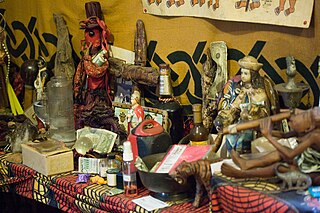
Spirit possession is an unusual or an altered state of consciousness and associated behaviors which are purportedly caused by the control of a human body by spirits, ghosts, demons, or gods. The concept of spirit possession exists in many cultures and religions, including Buddhism, Christianity, Haitian Vodou, Dominican Vodou, Hinduism, Islam, Wicca, and Southeast Asian, African, and Native American traditions. Depending on the cultural context in which it is found, possession may be considered voluntary or involuntary and may be considered to have beneficial or detrimental effects on the host.

Hoodoo is a set of spiritual practices, traditions, and beliefs that were created by enslaved Africans in the Southern United States from various traditional African spiritualities, Christianity and elements of indigenous botanical knowledge. Practitioners of Hoodoo are called rootworkers, conjure doctors, conjure man or conjure woman, root doctors, Hoodoo doctors, and swampers. Regional synonyms for Hoodoo include conjure or rootwork. As a syncretic spiritual system, it also incorporates Islam brought over by enslaved West African Muslims and Spiritualism. Scholars define Hoodoo as a folk religion. Folk religions are syncretic traditions between two or more cultural religions, in this case African indigenous spirituality and Abrahamic religion.
Jamaican culture consists of the religion, norms, values, and lifestyle that define the people of Jamaica. The culture is mixed, with an ethnically diverse society, stemming from a history of inhabitants beginning with the original inhabitants of Jamaica [the tainos] The Spaniards originally brought slavery to Jamaica. Then they were overthrown by the English. Jamaica later gained emancipation on 1 August 1838, and independence from the British on 6 August 1962. Black slaves became the dominant cultural force as they suffered and resisted the harsh conditions of forced labour. After the abolition of slavery, Chinese and Indian migrants were transported to the island as indentured workers, bringing with them ideas from their country.

African diaspora religions, also described as Afro-American religions, are a number of related beliefs that developed in the Americas in various nations of the Caribbean, Latin America and the Southern United States. They derive from traditional African religions with some influence from other religious traditions, notably Christianity and Islam.
Obeah, or Obayi, is a series of African diasporic spell-casting and healing traditions found in the former British colonies of the Caribbean. These traditions derive much from traditional West African practices that have undergone cultural creolization. There is much regional variation in the practice of Obeah, which is followed by practitioners called Obeahmen and Obeahwomen.
Kumina is an Afro-Jamaican religion. Kumina has practices that include secular ceremonies, dance and music that developed from the beliefs and traditions brought to the island by Kongo enslaved people and indentured labourers, from the Congo region of West Central Africa, during the post-emancipation era. It is mostly associated with the parish of St. Thomas in the east of the island. However, the practice spread to the parishes of Portland, St. Mary and St. Catherine, and the city of Kingston.
The Spiritual Baptist faith is a religion created by persons of African ancestry in the plantations they came to in the former British West Indies countries predominantly in the islands of a Grenada, Saint Vincent and the Grenadines, Tobago and the Virgin Islands. It is syncretic Afro-Caribbean religion that combines elements of the many varied traditional African religions brought by the enslaved populations combined with Christianity. Spiritual Baptists consider themselves to be Christians.
Tambor is a coastal Afro-Venezuelan music and dance. It is a cultural manifestation originating in the slaves from Africa. The drums are of Kongo origin, as are most musical genres of Afro-Venezuelan origin. The Tambores are done with the playing of a cumaco which is a long cylinder-shaped drum played on the ground while the player sits on it and plays. It also consists of drums known as campanas which are played by sitting down in a chair and playing them with the hands. These drums are often used for religious ceremonies. In the Afro-Catholic community, it is used to honour and invoke San Juan or some other Saint. In the Maria Lionza context, the drums are used to invoke the spirits to possess the materia or medium as well as to animate the spirit and give it force.

Espiritismo is a term used in Latin America and the Caribbean to refer to the popular belief that evolved and less evolved spirits can affect health, luck and other aspects of human life.

Louisiana Voodoo, also known as New Orleans Voodoo, is an African diasporic religion that originated in Louisiana, now in the southern United States. It arose through a process of syncretism between the traditional religions of West Africa, the Roman Catholic form of Christianity, and Haitian Vodou. No central authority is in control of Louisiana Voodoo, which is organized through autonomous groups.
Afro-Jamaicans are Jamaicans of predominant Sub-Saharan African descent. They represent the largest ethnic group in the country. Most Jamaicans of mixed-race descent self-report as just Jamaican.
Christianity is predominant religion in Jamaica. Jamaica's laws establish freedom of religion and prohibit religious discrimination. According to the census of 2011, 69% of the population are Christians of various denominations, while 21% stated they had no religion.

Akan religion comprises the traditional beliefs and religious practices of the Akan people of Ghana and eastern Ivory Coast. Akan religion is referred to as Akom Although most Akan people have identified as Christians since the early 20th century, Akan religion remains practiced by some and is often syncretized with Christianity. The Akan have many subgroups, so the religion varies greatly by region and subgroup. Similar to other traditional religions of West and Central Africa such as West African Vodun, Yoruba religion, or Odinani, Akan cosmology consists of a senior god who generally does not interact with humans and many gods who assist humans.
Christian revivalism is increased spiritual interest or renewal in the life of a church congregation or society, with a local, national or global effect. This should be distinguished from the use of the term "revival" to refer to an evangelistic meeting or series of meetings. Proponents view revivals as the restoration of the church itself to a vital and fervent relationship with God after a period of moral decline.
Nyabinghi or Nyabingi is a legendary woman in the culture of Rwanda, Uganda and Tanzania, where religions or 'possession cults' formed around her.

The Book of Night Women is a 2009 novel by Jamaican author Marlon James. The book was first published in hardback on February 19, 2009, by Riverhead Books. The story follows Lilith, a young woman born into slavery, who challenges the boundaries of what is expected of her.
The traditional Jamaican Maroon religion, otherwise known as Kumfu, was developed by a mixing of West and Central African religious practices in Maroon communities. While the traditional religion of the Maroons was absorbed by Christianity due to conversions in Maroon communities, many old practices continued on. Some have speculated that Jamaican Maroon religion helped the development of Kumina and Convince. The religious Kromanti dance is still practiced today but not always with the full religious connotation as in the past.
Convince, also known as Bongo or Flenke, is a religion from eastern Jamaica. It has roots in Kumina and Jamaican Maroon religion.
Comfa is a folk religion in Guyana also known as Spiritualism or Faithism. The word "Comfa" is used by non-practitioners as a generic term for spirit possession in Guyana. However, the word "Comfa" is also a term to define the greater folk religion involving spirit possession originating in Guyana.
Kromanti dance or Kromanti play is a Jamaican Maroon religious ceremony practiced by Jamaican Maroons. It is rooted in traditional African music and religious practices, especially those of the Akan people of Ghana. The name Kromanti derives from Kormantin where a historical slave fort in the coast of Ghana was located. Many slaves shipped to Jamaica during the Atlantic Slave trade originated from present–day Ghana in West Africa.






